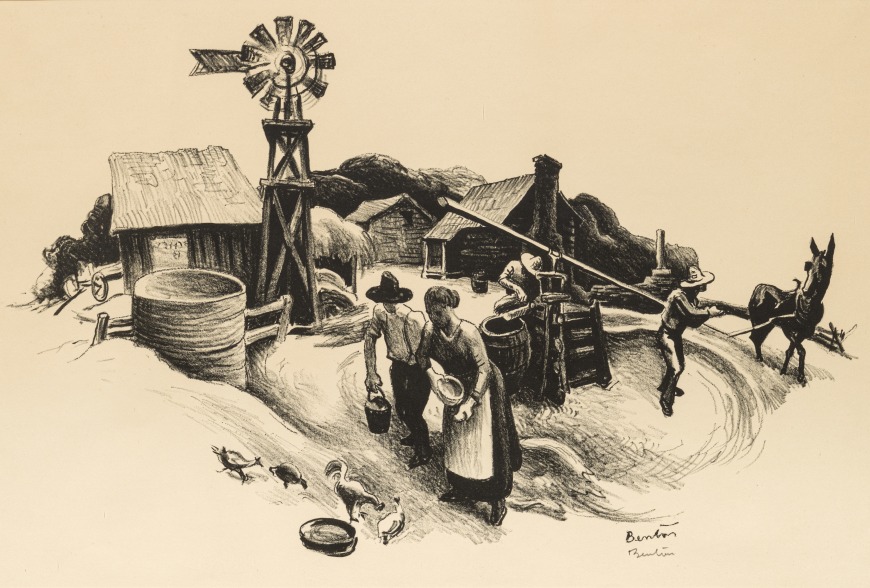Thomas H. Benton
Kansas Farmyard, 1936
1889-1975
Lithograph
11 x 16 1/2 in
27.9 x 41.9 cm
This painting is available to view at our Montreal gallery.
27.9 x 41.9 cm
$1,500
Inscriptions
signed twice by the artist, in ink and pencil, ‘Benton/ Benton’ (lower right)Provenance
Private collection, Town of Mount Royal, Quebec
Thomas Hart Benton is perhaps the best known muralist associated with the American Scene Painting movement of the 1930s. Benton's vivid, stylized portrayal of pre-industrial agrarian life and his later emphasis on the plight of the working class in the post-Depression era earned him a reputation as a social activist, and he gained publicity through public works projects. Within the broad American Scene Painting Movement, Benton is most closely associated with Regionalism a movement that rejected modernism in favor of a naturalistic and representational style. Regionalism gained recognition through public art works in highly visible locations such as banks, post offices, and political buildings.
Source: http://xroads.virginia.edu/~am482_04/am_scene/bentonbio.html
Thomas Hart Benton, one of the leaders of the Regionalist movement in American art, was a prolific painter, muralist, draughtsman, and sculptor from childhood until the end of his life in 1975. Today he is best known for his realist depictions of American life, which, in his own time, were perceived as directly opposed to modernist movements cultivated in Europe. His paintings, largely vignettes of daily life and ordinary rural characters, were simultaneously praised for their frankness and criticized for their gritty representations of American culture and history.
[...] By the late ‘20s, Benton’s interest in representing scenes of everyday American life with the visual language of realism gave way to a style that brought him financial success, critical attention, and high profile commissions. This would be branded as Regionalism in the 1930s. In 1934, a Time feature, “The U.S. Scene,” popularized the group and presented Benton as the movement’s leader. Described as the Midwestern mode of painting, Regionalism aligned Benton with artists John Steuart Curry (from Kansas) and Grant Wood (from Iowa).
Source: https://pendergastkc.org/article/biography/thomas-hart-benton
Source: http://xroads.virginia.edu/~am482_04/am_scene/bentonbio.html
Thomas Hart Benton, one of the leaders of the Regionalist movement in American art, was a prolific painter, muralist, draughtsman, and sculptor from childhood until the end of his life in 1975. Today he is best known for his realist depictions of American life, which, in his own time, were perceived as directly opposed to modernist movements cultivated in Europe. His paintings, largely vignettes of daily life and ordinary rural characters, were simultaneously praised for their frankness and criticized for their gritty representations of American culture and history.
[...] By the late ‘20s, Benton’s interest in representing scenes of everyday American life with the visual language of realism gave way to a style that brought him financial success, critical attention, and high profile commissions. This would be branded as Regionalism in the 1930s. In 1934, a Time feature, “The U.S. Scene,” popularized the group and presented Benton as the movement’s leader. Described as the Midwestern mode of painting, Regionalism aligned Benton with artists John Steuart Curry (from Kansas) and Grant Wood (from Iowa).
Source: https://pendergastkc.org/article/biography/thomas-hart-benton













